Queen Mary Passenger and Crew Accomodations
The Queen Mary as completed in 1936 was designed to carry 2,139 passengers
in three classes. There was first class whose cabins occupied the central
part of the ship; second class whose cabins were in the stern, and third
class whose cabins were in the least desirable part of the ship, in the
bow and below near the propellors. Those in the bow always felt the most
motion of the ship at sea.
Those in the center of the ship might have noticed a slight movement if
any at all. Those in the rear of the ship, while not noticing nearly as
much movement as those in the bow, had another annoyance to contend with.
This was the vibration from the four propellers below them. The
propellers were always a headache for ship builders. The French Line's
Normandie on its first few voyages had
such a strong vibration in the stern of the ship that it was impossible
for anyone with cabins there to sleep.
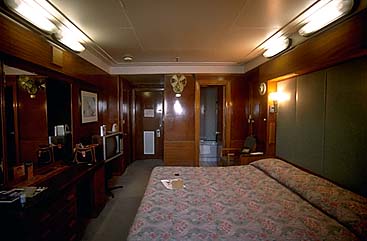
First Class Cabin, M007
When I planned my trip to California, I was too late to get a small
inexpensive cabin. The only cabin that was left was an "Original 1930s
First Class Cabin." Since I wanted to stay on board the ship I had no
choice but to pay the extra charge and get a room. Apparently there was a
convention on board that day having something to do with snack food. My
cabin is on M deck, on the starboard side of the ship. I had two port
holes to look out of at the water and City of Long Beach. The room was
very nicely maintained, and things I have heard about mattresses being
very worn out didn't apply to my cabin. The bed was very comfortable and
I slept well. My cabin was a bit on the warm side (then again, I *am*
from the Pacific Northwest), and I slept with the portholes open. The
cooling ports made a bit of noise that took getting used to at first, but
eventually became merely white noise. The term "First Class" is a bit
inaccurate. When Cunard launched the Queen Mary in to service, the phrase
"First Class" was called "Cabin Class." Second Class was
called "Tourist Class" and Third Class remained, having been known in the
past as Steerage. Later, "Cabin Class" (1st Class in 1936) was changed to
"First Class",
"Tourist Class" (2nd Class in 1936) was changed to "Cabin Class", and
"Third Class" (3rd Class in 1936) was changed to "Tourist Class."
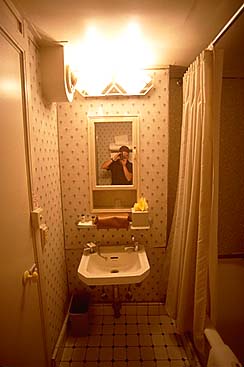
Bathroom, Cabin M007
First and second class cabins on the Queen Mary have their own bathrooms.
It was the first Cunard ship to offer this. Passengers on most earlier
vessels had a basin in their cabin but when it came time to bathe
they were relegated to a community bathroom down the hall. The fixtures
in my bathroom looked original 1936 except for the new shower controls
and the sink faucet. Where the soap dish is was the cold spigot,
and the hot spigot was on the right. I was pleased to see the
sink
and toilet to be the original fixtures made by Shanks of England. I
found water pressure adequate and I had a wonderful bath after walking
all over the ship for more than 12 hours.
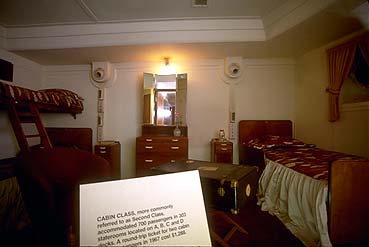
A mockup of a second
class cabin
After the Queen Mary was handed over to the City of Long Beach in 1967,
the ship was transformed in to a floating convention center and hotel.
Most of the second class cabins were gutted and some were incorporated
in to the hotel today which occupies only Main, A and B decks. The second
class pool, almost identical to the first class pool installed on the
Queen Elizabeth, was sadly gutted to make space for the convention center
facilities. Second class cabins were originally located on A,B,C (later
called 'R' Deck as the 'Restaraunt' was on that deck), D and
E decks in the stern of the ship. The second class also had their own
promenade area, on the stern of M deck. The mockup area is now in what
used to be the Third Class Smoking Room.
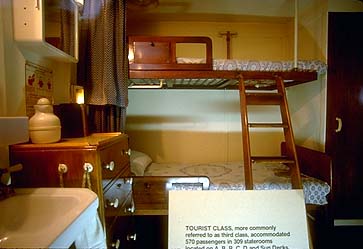
Third Class Cabin mockup
Third class had to endure sleeping on hard bunks and shared bathroom
facilities down the hall from their cabin, not to mention the constant
strongly noticable movement of the ship as the cabins were located in the
bow. I cannot imagine sleeping under such conditions, let alone shaving.
But then again I am not lucky enough to have experienced a sea crossing
and can only imagine that I would be a little seasick the first time, as
many must have been in third class on their first voyage. The third class
cabins were originally located on C,D and E decks.
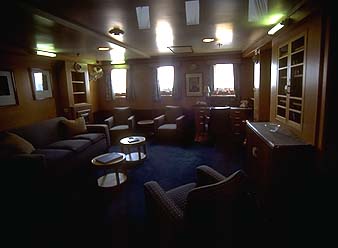
The Captains quarters
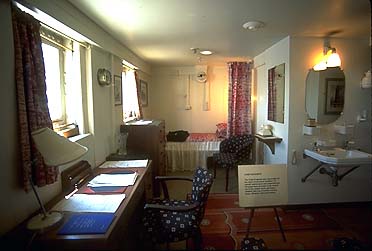
The Chief Officer's
quarters
The Captain and Chief Officer, as well as the First Officer and Staff
Captain and other ships officers all had quarters directly below and
slightly behind the bridge. Except for the Captain and Chief Officer's
quarters, the others were converted in to offices and storage.

The Purser's Desk mockup
The captain was responsible for the safe passage from port to port. The
purser, on the other hand, was responsible for the smooth running of
the ships staff and making sure the passengers got what they needed. The
pursers desk is where all passengers would go to complain about poor
service, food, entertainment or the like. It was the pursers job to
listen calmly and to put the passenger at ease. I have read that the
purser of the Normandie, Henri Villar,
had a phone connected to a foot
switch on which he would press if a passenger was getting carried away
with conversation. The phone would ring, and he would answer and say
"Yes, at your command, Captain" thus allowing himself a polite exit from
the annoying passenger. The pursers desk as seen here was nearly lost
when the ship was gutted in 1968-71. It laid on the dock for a while
before being re-installed on the ship as part of the mockup area.








 Return to Main Page
Return to Main Page